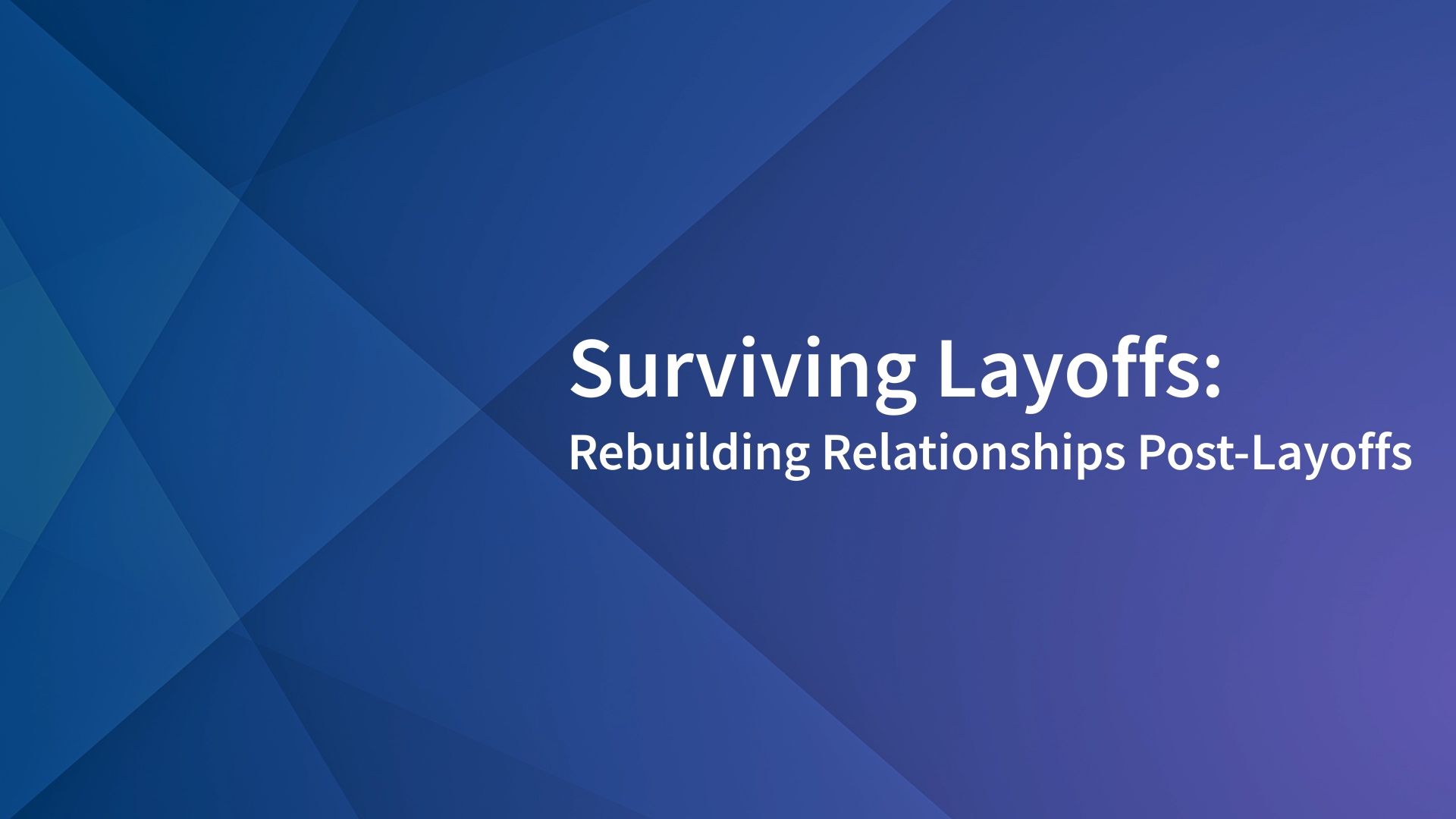Heather Myers, Ph.D., shares three steps for leadership to rebuild strained relationships after layoffs with the remaining employees in the penultimate part of our surviving layoffs series.
Learn how to ensure proper care for your leadership in the series finale here.
ICYMI, for surviving layoffs Heather previously covered:
Watch the full series here.
Transcript:
Hi, my name's Heather Myers. I'm the Chief Psychology Officer at Traitify.
I’d like to welcome you today to the fourth video in our Surviving Layoff series. If you missed any of the earlier videos you can find a link to them [here].
In our last video, we talked about how to reduce the impact of layoffs on remaining employees through early notification, fairness, and manager training. However, even if your organization follows these steps, relationships can still be damaged, and you may have some employees who are distrustful of the organization and many employees who are anxious or fearful.
So in this video we’ll discuss three steps that you can take to rebuild these relationships.
First, measure and report meaningful success outcomes of the layoffs.
Report on any cost-savings or health metrics of the organization, and show how these improve over time. Tracking these changes and reporting them to your employees can help alleviate fears that there will be more layoffs and improve their sense of job security.
Second, set up support resources for the remaining team members.
It is important for your employees to have a neutral place to air any concerns or grievances. Additionally, setting up internal peer support groups can be a great way for your team members to discuss what they’re feeling and get any advice from people going through the same thing without worrying about what their managers might hear or think.
Additionally, it is so important to remind people of any external resources available to them. These may be mental health resources or coaches. But any resources that you have that are provided outside of your organization, it's important to remind your employees of that at this time, as well.
And then finally, show commitment to continued Learning and Development for your employees. Let them know that you're going to look to them for positions, internal mobility, and promotion. Doing these things shows your employees that you're invested in them, that you care about them, and that you want them to succeed along with your organization.
Third, make sure that your employees get enough one-on-one time with their managers.
Managers should try to touch base with their direct reports daily, if it all possible -- especially the first week or two after the layoffs. They need to listen to any complaints or concerns that their employees have and give them a space to vent.
Then, they can try to shift the focus on to things that they can control. For example, managers should make sure that their direct reports eliminate any unnecessary or time-wasting meetings from their schedule, particularly if they're already feeling overworked and stressed out.
Additionally, they should ensure that the workload of their direct reports is not unreasonable, and if it is they should adjust that accordingly. It is far better to delay a project or a deadline, than to put too much work on an already stressed population.
In summary, reporting on successes of the organization, providing support resources, and increasing thoughtful one-on-one time with managers can help organizations make great strides in repairing these relationships.
In our final video, we’ll discuss what your leadership team can do to help care for themselves during difficult times.
Thank you, and have a great day.
To learn how to survive layoffs by leveraging fast, visual-based assessments, connect with Traitify.
Sources:
- Brockner, J., Davy, J., & Carter, C. (1985). Layoffs, self-esteem, and survivor guilt: Motivational, affective, and attitudinal consequences. Organizational Behavior and Human Decision Processes, 36(2), 229–244. https://doi.org/10.1016/0749-5978(85)90014-7
- Brockner, J., Greenberg, J., Brockner, A., Bortz, J., Davy, J., & Carter, C. (1986). Layoffs, Equity Theory, and Work Performance: Further Evidence of the Impact of Survivor Guilt. Academy of Management Journal, 29(2), 373–384. https://doi.org/10.5465/256193
- Campbell-jamison, F., Worrall, L., & Cooper, C. (2001). Downsizing in Britain and its effects on survivors and their organizations. Anxiety, Stress & Coping, 14(1), 35–58. https://doi.org/10.1080/10615800108248347
- IMPACT Group. (2017). The SMART and Compassionate Guide to Reducing Your Staff [E-book]. https://cdn2.hubspot.net/hubfs/1856621/Reducing_Your_Staff_The_SMART_and_Compassionate_Guide.pdf
- Murphy, M. (2015). Don’t Expect Layoff Survivors to be Grateful. Leadership IQ. https://www.leadershipiq.com/blogs/leadershipiq/29062401-dont-expect-layoff-survivors-to-be-grateful
- Murphy, M. (2019, October 21). How To Help Your Employees Overcome Survivor Guilt After A Layoff. Forbes. https://www.forbes.com/sites/markmurphy/2019/10/22/how-to-help-your-employees-overcome-survivor-guilt-after-a-layoff/#52b201e92edf
- Wolfe, H. (2004). Survivor Syndrome: Key Considerations and Practical Steps. Institute for Employment Studies. https://www.employment-studies.co.uk/system/files/resources/files/mp28.pdf





